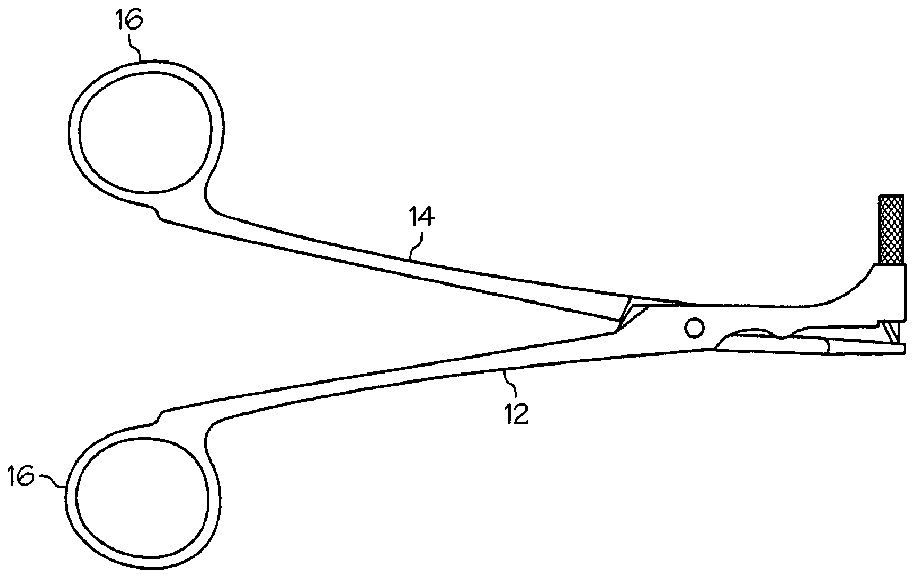
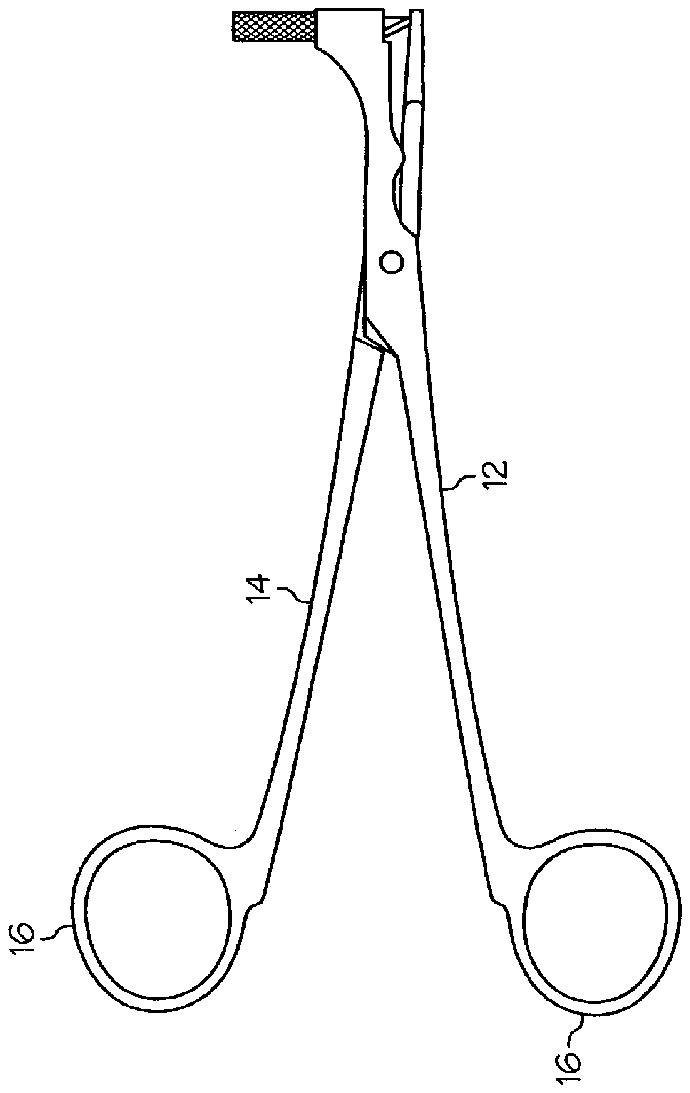
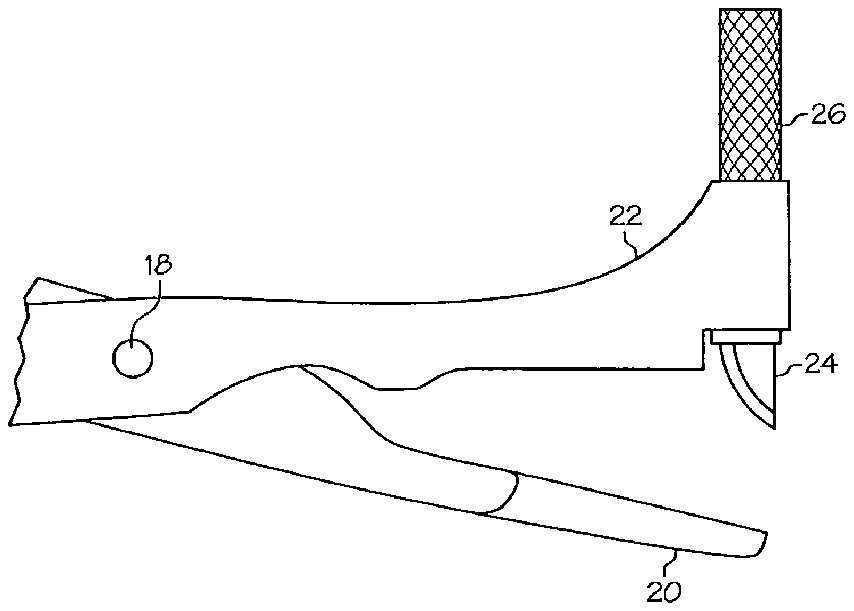
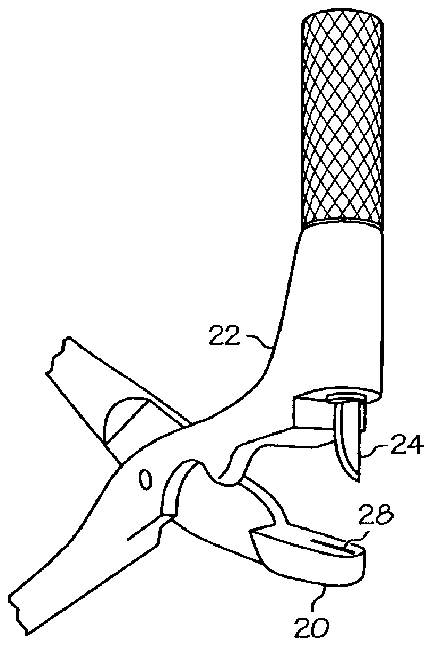
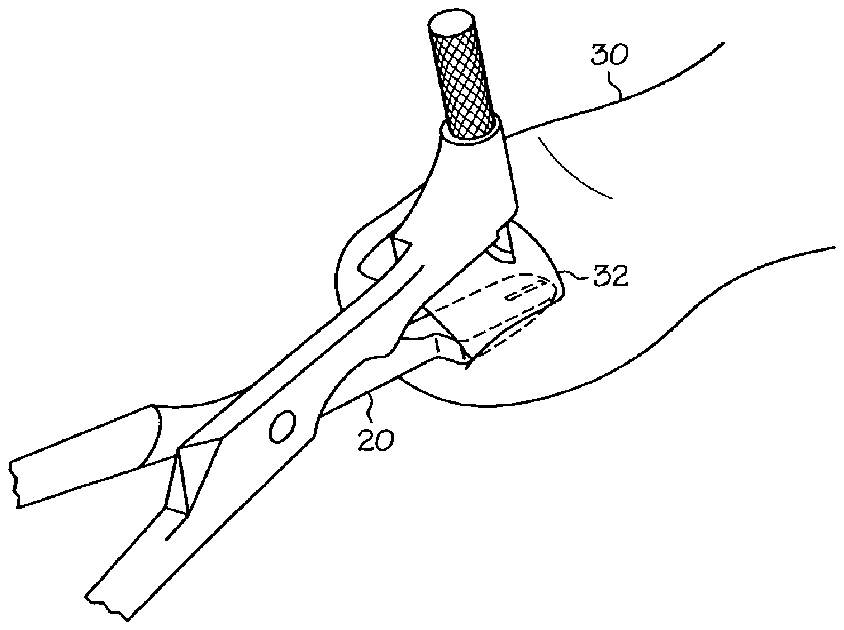
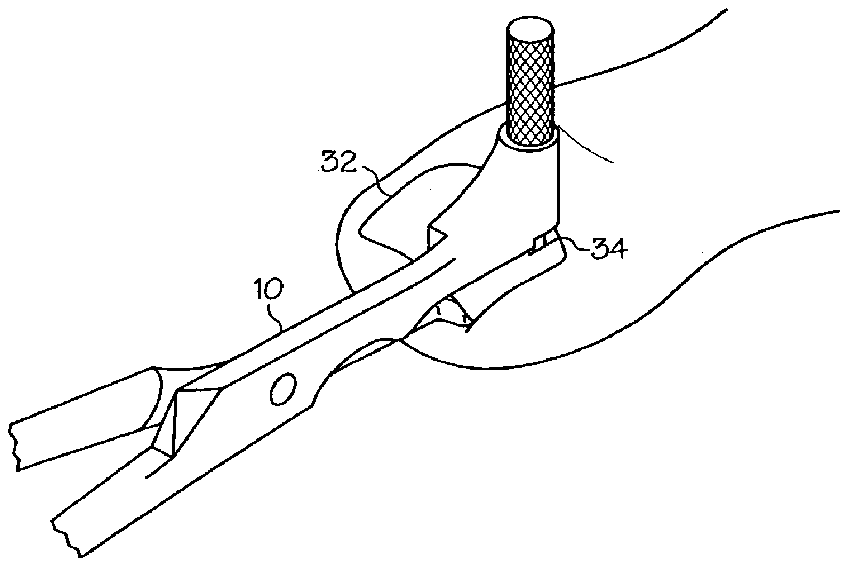
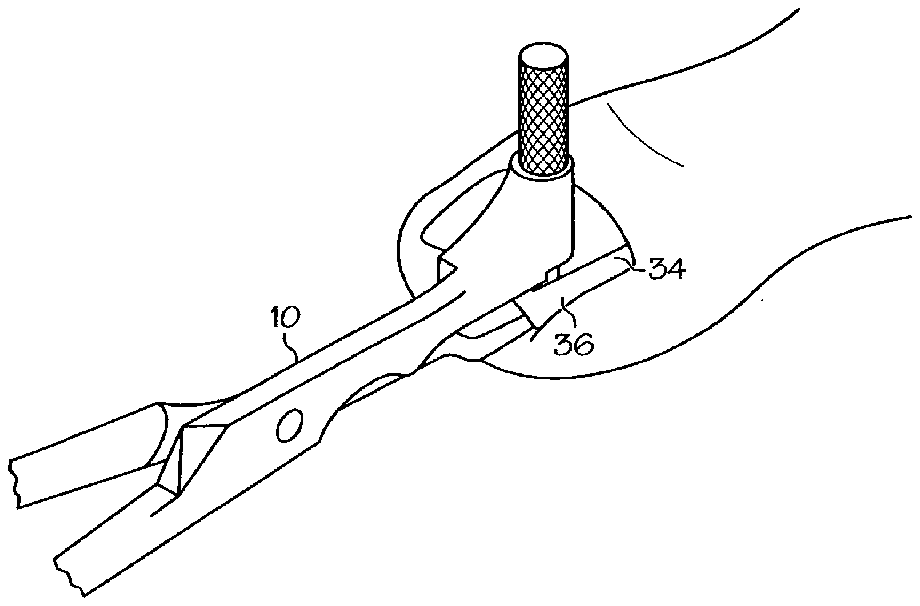
- 10nail cutter device
- 12first member
- 14second member
- 18pivot about point
- 20separator tongue
- 22cutter end
- 24blade
- 26release/locking mechanism
- 28slotted recess
- 32nail
- 34nail
Abstract
A nail slicer apparatus for treatment of an ingrown nail includes upper and lower jaw members with handles hingedly connected. The upper jaw member contains a blade holder with the cutting blade oriented perpendicular to the surface of the lower jaw member when the apparatus is in cutting or slicing position.
Description
CROSS REFERENCE TO RELATED APPLICATIONS
[0001] None.
FIELD OF THE INVENTION
[0002] The present invention relates to an apparatus for slicing nails, particularly ingrown toenails or fingernails to facilitate removal of a section of the affected nail.
BACKGROUND OF THE INVENTION
[0003] It will be appreciated by those skilled in the art that ingrown nails (usually toenails) are a common malady that often must be corrected by an outpatient operative procedure. The phrase “ingrown toenail” is used to describe the condition where the edge of the toenail or fingernail grows into the soft tissue of the digit, causing inflammation, and on occasion an abscess. When an ingrown toenail occurs, the surgical procedure used to correct it to split the nail and remove the portion of the nail that has turned and grown radially into the soft tissue of the digit.
[0004] A corrective procedure for ingrown toenails is illustrated in U.S. Pat. No. 4,936,322 issued to DeSantis in 1990. DeSantis describes the procedure, and in FIGS. 5 and 6 illustrates the procedure of splitting the nail so that the ingrown portion of the nail can be removed. DeSantis' description of the procedure is done in conjunction with the description of his invention for an “Ingrown Toenail Part Remover” which he describes and claims in the referenced patent.
[0005] As DeSantis describes, the related art devices include pliers and scissor type devices, such devices being by far and away the norm for use in executing this procedure. DeSantis maintains that the use of separate depressors to separate the soft tissue of the nail may result in unnecessary trauma to the affected region because of multiple insertions of separators, cutting devices, etc. However, DeSantis fails to recognize that his device requires an excessive amount of force directed towards the base of the nail and can cause unnecessary damage to the soft tissue.
[0006] A “Nail Splitter Device for Implementing a Wedge Resection Procedure to Remove an Ingrown Toenail” is described in U.S. Pat. No. 5,437,679 to Gaillard. This device is a scissor or pliers type instrument having a flat separator tongue with a rounded nose which is hingedly connected to a cutter blade for severing the nail once the separator tongue has been inserted between the nail and the soft tissue.
[0007] A problem with the Gaillard device is that it utilizes a scissor or pliers type instrument to apply a cutting force from the end of the nail towards the base of the nail. Devices of this type pose an additional risk of trauma to the underlying tissue as well as the nail and digit itself because cutting action and associated force is directed towards the nail base and digit. If the user applies too much force while cutting, unnecessary and excessive cuts can easily result.
[0008] The Gaillard device provides a hawk-nose on the tip of the cutter blade which mates with the rounded nose of the separator tongue so that when the blade is pressed against the tongue and the nail as cut, the cut can be made to a point immediately adjacent the cuticle of the digit. The purpose of the hawk nose tip, according to the Gaillard patent, is to avoid trauma to the cuticle. However, the nail area under the cuticle is normally soft and eggshell-like. It can normally be severed without cutting. If cutting is necessary, a clean slice made through the cuticle will not normally cause trauma.
[0009] Applicant overcomes the deficiencies of the related art with a unique instrument which is an improvement over the instruments with which this procedure is currently undertaken.
SUMMARY OF THE INVENTION
[0010] The current apparatus offered by Applicant is a scissors or pliers type construction with a lower jaw acting as a separator tongue and an upper jaw holding a cutter blade in place. This device offers the user the opportunity to use the separator tongue or lower jaw to separate the soft tissue from the affected nail area. The handles of the device are then activated to allow the blade to cut into the fingernail or toenail. With the device so engaged, the user merely pulls back on the device and makes a clean cut or slice of the affected nail.
BRIEF DESCRIPTION OF DRAWINGS
[0011] The character of the invention, however, may be best understood by reference to one of its structural forms, as illustrated by the accompanying drawings described herein.
[0012] FIG. 1 is a profile view of the nail cutter device.
[0013] FIG. 2 is a close-up side view of the lower and upper jaws of the nail cutter device.
[0014] FIG. 3 is a perspective view of the lower and upper jaws of the nail cutter device.
[0015] FIG. 4 shows the separator tongue inserted under a toenail.
[0016] FIG. 5 shows the nail cutter beginning to cut a toenail at the base of the nail.
[0017] FIG. 6 is shows the nail cutter near the end of the cutting process.
DETAILED DESCRIPTION OF THE PREFERRED EMBODIMENTS
[0018] Referring to FIG. 1 , which best shows the general features of a preferred embodiment of the invention, the nail cutter device 10 has a first member 12 with a handle at one end and a cutter blade attachment at the opposite end. A second member 14 has a handle at one end and a lower jaw or separator tongue at the opposite end.
[0019] FIG. 2 shows the cutter and separator end of the first and second members. The first and second members are fastened together and pivot about point 18 . The cutter end 22 provides a recess for a blade 24 held in place by a release/locking mechanism 26 . The lower jaw or separator tongue 20 has a smooth upper surface to facilitate insertion and removal of the second member under a fingernail or toenail.
[0020] As can be seen in FIG. 3 , the separator tongue 20 includes a slotted recess 28 to accommodate the blade 24 during the cutting process. The slot has several functions. It provides a recess that allows the blade to completely penetrate the nail and also provides the blade with support while the cut is being made. The recess also prevents dulling of the blade that would result from contact with a surface of the tool itself. The recess, in conjunction with the separator tongue, also prevents the blade from cutting any of the soft tissue under the nail.
[0021] To utilize this device, the separator tongue 20 is inserted under a nail 32 to separate the soft tissue from the nail. In some cases the separator tongue may easily be inserted up to the base of the nail as seen in FIG. 4 . The handles of the device are then pressed together to engage the cutter and begin to cut the nail 34 as shown in FIG. 5 . While holding the handles together, the operator may simply draw back with the device and slice the entire length of the nail as illustrated in FIG. 6 . The cutting force is thereby directed away from the base of the nail.
[0022] Once the nail is sliced, pliers, forceps or a similar device may be utilized to remove the severed section of nail. The nail slicer apparatus may also be used to hold the nail between the blade and the separator tongue. The operator can then apply a slight twisting motion and remove the nail.
[0023] In some cases, the lower jaw or separator tongue will not easily separate the nail from the underlying tissue. In these cases, the operator merely inserts the lower jaw or separator tongue under the nail as far possible. The nail can then be sliced from this point to the outer edge of the nail. The operator can reinsert the lower jaw or separator tongue under the nail and apply a slight twisting motion to further loosen the nail from the underlying tissue. The separator tongue will further separate the nail from the underlying tissue. Incremental cuts can be made in this fashion until the nail is removed.
CONCLUSIONS, OTHER EMBODIMENTS, AND SCOPE OF INVENTION
[0024] The apparatus as shown and described utilizes scissors type handles for holding the instrument. Pliers type handles or any suitable handle arrangement can be utilized without deviating from the intended scope of the invention. Various hinge components known to one skilled in the art are contemplated. Embodiments with ergonomic grips or handles are contemplated as well.
[0025] The lower jaw or separator tongue can also vary in shape and size to facilitate separation of the nail from the underlying soft tissue. Material utilized is typically stainless steel but any suitable material commonly used in medical instruments is contemplated.
[0026] The blade holder can be adapted to hold a variety of common surgical scalpel blades to allow for ease of insertion, adjustment and removal. The blade should be aligned parallel to the lower jaw or separator tongue with the cutting edge of the blade facing the handle end of the apparatus to facilitate the pulling and slicing motion.
[0027] While the lower jaw or separator tongue can utilize a recess or slot to accommodate the blade during slicing, other embodiments could eliminate the recess or slot. If a recess or slot is not utilized, the blade should be adjusted to approximately meet the surface of the lower jaw/separator tongue during cutting or slicing.
[0028] By use of the present invention, the nail cutting or slicing procedure can be implemented with minimum traumatization to the area. The present invention will allow a user to minimize error by concentrating on 1) separating the nail from the underlying soft tissue, and 2) slicing the nail in a continuous fluid motion. Use of this device can also reduce the pain associated with the procedure and reduce the healing period that the patient experiences after the procedure is completed.
[0029] While this apparatus is useful in treating ingrown nails, it can be similarly utilized to cut or slice any nail that has to be removed due to medical necessity. Although shown in use on humans, its application can extend beyond the treatment of humans.
[0030] Thus, although there have been described particular embodiments of the present invention of a new and useful “Nail Slicer Apparatus for Treatment of Ingrown Toenails”, it is not intended that such references be construed as limitations upon the scope of this invention except as set forth in the following claims.


